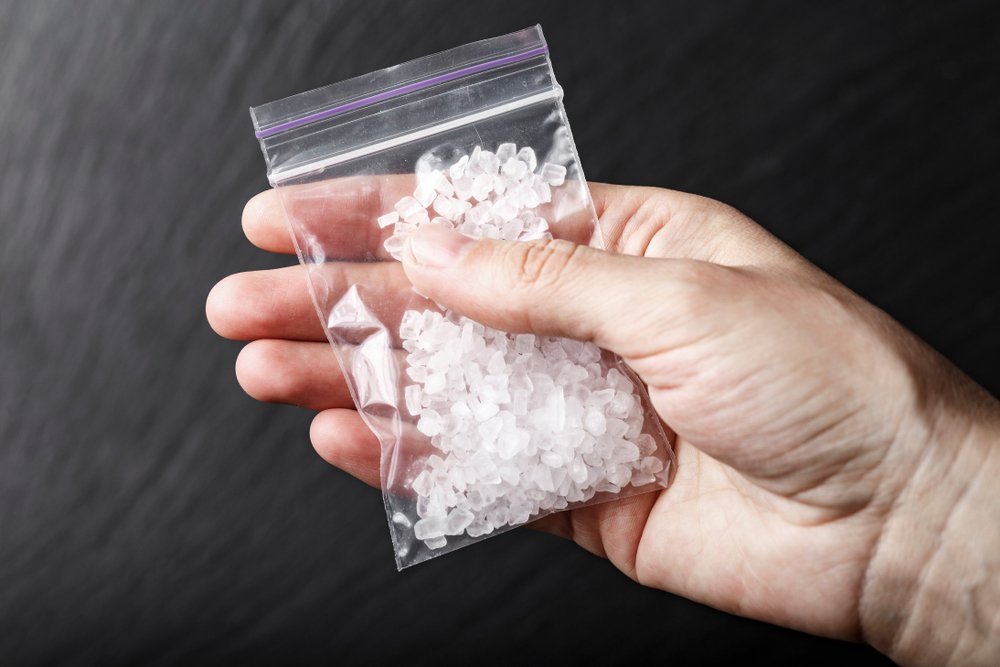California Health and Safety Code § 11378 HS makes it a crime to have possession of methamphetamine with the intent to sell it. This felony offense is punishable by up to 3 years of jail time and fines of up to $10,000.
A conviction also counts as a deportable offense for non-citizens.

HS 11378 prohibits the possession for sale of methamphetamine in California.
Examples
- carrying baggies of meth in a backpack for the purpose of selling it to someone.
- driving a car to a “point of sale” with meth in the vehicle’s trunk.
- storing methamphetamine tablets in a closet for a few days before completing a sale.
Defenses
Criminal defense lawyers draw upon several legal strategies to help you contest charges under this statute. A few common ones include showing that:
- you did not possess meth with an “intent” to sell the drug,
- you did not “possess” meth, and/or
- law enforcement conducted an unlawful search and seizure.
Penalties
A violation of Health and Safety Code Section 11378 is a felony offense (as opposed to an infraction or a misdemeanor).
The crime is punishable by:
- custody in county jail for up to three years, and/or
- a maximum fine of $10,000.
Our California criminal defense attorneys will explain the following in this article:
- 1. What does it mean to possess meth with the intent to sell?
- 2. Are there defenses to Health & Safety Code 11378 HS?
- 3. What are the penalties?
- 4. Are there related offenses?

Health and Safety Code 11378 HS makes it illegal to possess methamphetamine with the intent to sell the drug.
1. What does it mean to possess meth with the intent to sell?
Under California’s criminal laws, you are is guilty of possession for sale of meth if all the following are true:
- you unlawfully possessed methamphetamine,
- you knew of the drug’s presence,
- you knew of the substance’s nature or character as a controlled substance, and
- when you possessed the controlled substance, you intended to sell it.1
Note that HS 11378 makes it illegal to possess for sale meth and non-narcotic controlled substances, including stimulants, “party drugs,” and illegal steroids.2
As to the “possession” of an illegal drug, you do not have actually to hold or touch a substance to possess it. It is enough if you have control over it, either personally or through another person.3
To be guilty under this code section, you must possess enough meth so that it can be used as a controlled substance. This does not mean that you have to possess a large quantity of meth so that someone can get high.4
Rather, there has to be enough of the drug so that it can be used in the way someone would normally use methamphetamines (for example, smoke it, snort it, swallow it, etc.).5
You do not violate this law if you are a medical professional (such as a pharmacist or veterinarian) and sell methamphetamines in accordance with California and federal law.
2. Are there defenses to Health & Safety Code 11378 HS?
If you are accused of drug charges pursuant to this statute, you have the right to challenge them with a legal defense/disclaimer. Three common defenses include you showing that:
- you did not intend to sell meth.
- you did not possess the drug.
- police conducted an unlawful search and seizure.
2.1. No intent to sell
Recall that you are only guilty under this law if you possessed methamphetamine and had the intent to sell the drug. Therefore, you can always challenge a case by showing that you did not intend to sell meth. Perhaps, for example, you had the drug for personal use.
2.2. No possession
Recall, too, that you actually have to possess meth to be convicted under this statute. Also, “possession” carries a precise legal definition under the law. A defense, then, is for you to show that you did not possess a controlled substance.
2.3. Unlawful search and seizure
This is a common defense to challenge many types of drug crimes. Police must have a warrant, or a legal excuse for not having one, to lawfully conduct a search and seizure. This means you can assert the defense that you were arrested after the authorities conducted an invalid search and seizure.6

A violation of this statute can result in a fine and/or jail time.
3. What are the penalties?
A violation of this statute is a felony offense.
The crime is punishable by:
- custody in county jail (as opposed to a state prison sentence) for up to three years, and/or
- a maximum fine of $10,000.7
You are not eligible for drug diversion (drug treatment) instead of jail time if convicted under this code section.
Further, you can receive enhanced jail time if any of the following apply:
- you violated the law on the grounds of a drug treatment center, a “detox” facility, or a homeless shelter,8
- you had more than one kilogram of meth in your possession,9
- you used a minor’s help to violate the statute or intended to sell meth to a minor.10
Note that if you are a legal immigrant or legal alien, a conviction under HS 11378 could lead to deportation.
4. Are there related offenses?
There are several crimes related to the possession of meth for sale. These are:
- possession of methamphetamine – HS 11377,
- transporting or selling meth – HS 11379,
- possession of a controlled substance for sale – HS 11351,
- driving under the influence of drugs – VC 23152f, and
- being under the influence of a controlled substance – HS 11550.
4.1. Possession of methamphetamine – HS 11377
Per Health & Safety Code 11377, possession of meth is the crime where you unlawfully possess methamphetamines as well as certain other narcotics.
The term “possession” is defined in the same manner under this statute as under HS 11378.
4.2. Transporting or selling meth – HS 11379
Per Health & Safety Code 11379 HS, transporting or selling methamphetamine is the crime where you sell meth or transport it for sale.
Note that while HS 11378 criminalizes the possession of meth for sale, this statute focuses on the actual sale of meth and the transportation of it.
4.3. Possession of a controlled substance for sale – HS 11351
Under Health & Safety Code 11351 HS, possession of a controlled substance is the crime where you possess certain controlled substances in order to sell them.
Methamphetamine is a drug covered under this statute. Therefore, if you possess meth with the intent to sell the drug, then you can be charged under either HS 11378 or HS 11351.
4.4. Driving under the influence of drugs (DUID) – VC 23152f
Under Vehicle Code 23152f VC, DUID is the crime where you drive while under the influence of drugs.
Unlike with violations under HS 11378, violations of this statute can lead to either misdemeanor or felony charges.
4.5. Being under the influence of a controlled substance – HS 11550
Per Health & Safety Code 11550, being under the influence of a controlled substance is the crime where you are under the influence of a controlled substance or a narcotic drug that is not lawfully prescribed.
A violation of this law is a less severe crime when compared to a violation of HS 11378. The offense is a misdemeanor punishable by a maximum jail sentence of one year.
Legal References:
- CALCRIM No. 2302 – Possession for Sale of Controlled Substance. Judicial Council of California Criminal Jury Instructions (2020 edition). See also People v. Ramos (2016) 224 Cal.App.4th 99.
- California Health & Safety Code 11378 HS. The language of the code section reads as follows:11378. Except as otherwise provided in Article 7 (commencing with Section 4110) of Chapter 9 of Division 2 of the Business and Professions Code, a person who possesses for sale a controlled substance that meets any of the following criteria shall be punished by imprisonment pursuant to subdivision (h) of Section 1170 of the Penal Code:(1) The substance is classified in Schedule III, IV, or V and is not a narcotic drug, except the substance specified in subdivision (g) of Section 11056.(2) The substance is specified in subdivision (d) of Section 11054, except paragraphs (13), (14), (15), (20), (21), (22), and (23) of subdivision (d).
(3) The substance is specified in paragraph (11) of subdivision (c) of Section 11056.
(4) The substance is specified in paragraph (2) or (3) of subdivision (f) of Section 11054.
(5) The substance is specified in subdivision (d), (e), or (f), except paragraph (3) of subdivision (e) and subparagraphs (A) and (B) of paragraph (2) of subdivision (f), of Section 11055.
(Amended by Stats. 2013, Ch. 76, Sec. 110. (AB 383) Effective January 1, 2014.)
- CALCRIM No. 2302. For a discussion of simple possession vs. constructive possession, see People v. Barnes (1997) 57 Cal.App.4th 552.
- People v. Leal (1966) 64 Cal.2d 504.
- People v. Rubacalba (1993) 6 Cal.4th 62.
- See, for example, People v. Zabala (2018) 19 Cal.App.5th 335.
- California Health and Safety Code 11378 HS. See also California Penal Code 1170h PC.
- California Health and Safety Code 11380.7 HS.
- California Health and Safety Code 11370.4 HS.
- California Health and Safety Code 11353 HS.
